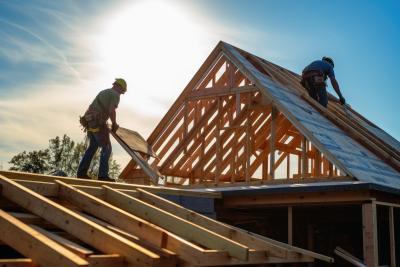Jun 12, 2025
In a unanimous vote on June 2, the Atlanta City Council approved a significant ordinance requiring all new and replacement roofs to be built with light-colored, reflective materials, commonly known as “cool roofs.” The ordinance, set to take effect in one year, is part of a growing effort to reduce the city’s vulnerability to extreme heat.
Georgia Tech researchers say the new policy marks a major step forward in climate adaptation, especially for heat-vulnerable communities, and could help position Atlanta as a national leader in urban resilience.
How Cool Roofs Can Help Hotlanta
”On any given summer afternoon, temperatures in Atlanta’s intown neighborhoods can be as much as 15 degrees Fahrenheit higher than in the city’s most forested areas,” said Brian Stone, professor in the School of City and Regional Planning and associate director of Georgia Tech’s Center for Urban Resilience and Analytics.
That spike is partly due to the urban heat island effect — a phenomenon driven by heat-trapping materials like concrete, asphalt, and dark rooftops, combined with the loss of trees and natural landscapes. The impacts are not just uncomfortable — they’re dangerous. Extreme heat is now one of the deadliest forms of weather in the U.S., with disproportionate effects on low-income communities, elderly residents, and those without access to air conditioning.
According to Patrick Kastner, assistant professor in the School of Architecture, rooftops are key contributors. “A major driver [of heat buildup] is dark, heat-absorbing material that stores solar energy during the day and then re-radiates it at night. If you look at a satellite image, for most of the day rooftops have more exposure to the sun than building facades — so the material choice there matters a lot.”
The Power of Reflective Roofs — and Trees
Stone and his students conducted modeling that found that widespread adoption of cool roofs across Atlanta could lower summer afternoon temperatures by more than 2 degrees Fahrenheit in many neighborhoods. That’s comparable to findings in other global cities like London, where cool roofs have reduced average temperatures by up to 2 degrees Celsius (3.6 F).
But cool roofs are only one part of a broader urban cooling strategy. In the same study, Stone’s team showed that planting trees in just half of Atlanta’s available planting zones could yield an even more dramatic effect, reducing temperatures by 4 F or more in some areas.
“Cool roofs are highly effective, but pairing them with increased urban tree cover would multiply the benefits, especially for neighborhoods currently lacking shade,” Stone said.
Equity and Energy Impacts
Atlanta’s ordinance requires cool roofing materials on new commercial construction and when existing commercial roofs are replaced. While that may sound like a technical design tweak, Stone emphasized its equity implications.
“Residents in South and West Atlanta, where tree canopy is sparse, and energy costs take up a larger share of household income, stand to gain the most,” Stone said. “When a cool roof is installed as part of a required roof replacement, those households will see meaningful reductions in cooling costs month after month.”
Kastner added that cool roofs could ease pressure on the electrical grid, lowering peak energy demand required for cooling during extreme heat and possibly reduce the risk of outages.
Durability, Maintenance, and Design Trade-offs
Stone noted that cool roofs tend to extend the life of roofing materials by limiting thermal degradation. However, he and Kastner also flagged some trade-offs.
For example, highly reflective coatings can create glare, especially on sloped roofs near neighboring buildings. The ordinance accounts for this by setting different standards for flat and pitched roofs. Maintenance is another consideration: over time, reflective coatings may degrade or become dirty, requiring periodic cleaning to maintain performance.
“Aesthetics and material compatibility may also challenge adoption when it comes to historic buildings or for roofs already outfitted with solar panels,” Kastner said. “But advancements in roofing technology, including high-performance materials that aren’t plain white, offer more flexible options than ever before.”
A Cool Roof Policy With National Impact
While cities like New York and Chicago have implemented cool roof programs for over a decade, Atlanta’s proposed ordinance is one of the most comprehensive in the country — applying to all roof types, not just flat industrial ones.
“Atlanta is steadily emerging as one of the most climate-resilient cities in the U.S.,” said Stone, pointing to the city’s urban forest and growing network of floodable parks as complementary resilience strategies. “Adding a best-in-class cool roofing ordinance to that portfolio is a bold step forward.”
And it could spark innovation across the region.
“Georgia Tech is uniquely positioned to help advance climate-resilient design,” Kastner said. “From research on advanced coatings to urban planning tools that target the most heat-vulnerable areas, we’re bringing science and policy together to shape cooler, healthier cities.”



